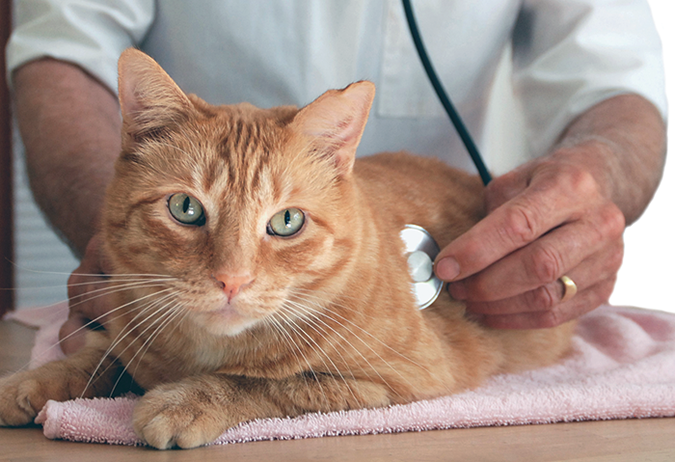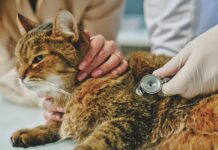ckellyphoto | Deposit Photos

Congestive heart failure (CHF) is often the stage of disease at which a cardiac problem is first diagnosed. When a cat has CHF, the heart no longer functions as an efficient pump, unable to bring enough oxygen and nutrients to the body cells and move waste products such as carbon dioxide out. Fluid buildup can occur, usually in the lungs (pulmonary edema) and in the chest cavity around the lungs (pleural effusion).
Cardiomyopathies, which are primary diseases of the heart muscle, are the most common cause of feline heart disease. Hypertrophiccardiomyopathy (HCM), which is characterized by thickening of the walls of the ventricles, is the most common form of cardiomyopathy in cats.
Symptoms
The initial signs of congestive heart failure, including lethargy, hiding, and a decreased appetite, are associated with many illnesses. The cardinal sign of CHF, though, is respiratory difficulty.
“Owners should be on the lookout for tachypnea (rapid breathing) and dyspnea (difficult or labored breathing),” says Bruce Kornreich DVM PhD DACVIM (Cardiology), Associate Director of the Cornell Feline Health Center.
Another possible symptom of cardiac problems is the loss of mobility in one or both hind limbs, which may be due to an aortic thromboembolism (clot). Clots can form in the heart of cats with heart disease and then be ejected from the heart, traveling via the aorta to the two main blood vessels that supply blood to the hind limbs, where they can obstruct blood flow. The lack of oxygen delivery and the buildup of toxins in the hind limbs can lead to significant pain and paralysis. An affected cat’s pulse will be reduced, and the leg(s) will usually feel cool. This is difficult to treat and often a sign of advanced cardiac disease. The prognosis for recovery is poor to grave. Note: You also may see this condition called a saddle thrombus or an aortic thromboembolism (ATE).
Diagnosis
A quick screening tool for cardiac disease in cats is the use of N-terminal pro brain natriuretic peptide (NT-pro BNP, a protein that is released from the myocardium or heart muscle when the heart is inappropriately stretched or stressed). NT-pro BNP is produced and excreted by heart muscle cells and helps control blood pressure and fluid balance. The amount excreted increases with dilation of the heart.
Many veterinary clinics have NT-pro BNP tests that can help establish an index of suspicion for heart disease and will use this screening test to distinguish respiratory distress due to cardiac disease vs. non-cardiac disease. While this blood test is a simple, inexpensive first step, a definitive diagnosis, both false positives and false negatives can occur, so additional testing may be required to make a definitive diagnosis.
Blood pressure and thyroid levels usually will be determined if there is concern for heart disease, as both kidney disease and hyperthyroidism can cause changes to the heart that mimic those seen with HCM.
Radiographs (x-rays) of the chest can evaluate the size of the heart and blood vessels and the status of the lungs. This is the only readily available modality to determine whether there are problems in the lungs. Radiographs can be used upon first diagnosis and to modify drug therapy in the face of CHF.
If your cat’s veterinarian detects an irregular heart rhythm during auscultation (listening with a stethoscope), the next step might be an electrocardiogram (EKG), which measures electrical activity in the heart. If your cat is weak or has collapsed, the EKG can be used to rule out cardiac arrhythmias (irregular heartbeats) as the cause. If the EKG appears abnormal, your veterinarian may request a consultation by a veterinary cardiologist.
The gold standard for evaluating cardiac function is the echocardiogram, a non-invasive radiological examination that uses sound waves to look at cardiac structure and function. There is no radiation involved in echocardiography, and while many veterinarians have the ability to perform this test in their practices, a board-certified veterinary cardiologist may be consulted in complicated cases or in the event that a practice does not have the necessary equipment or expertise.
Treatment
The treatment of cats with congestive heart failure focuses largely upon minimizing symptoms while trying to forestall disease progression. There is no cure for most causes of feline heart failure, but many cats can be controlled and gain quality time with their families with appropriate therapy.
The first line of defense is often a diuretic, which induces urination, thereby decreasing blood volume and minimizing fluid accumulation in the lungs and/or chest cavity. This facilitates easier breathing, and owners should be aware that this increase in urination will require that they clean litterboxes more frequently.
Other therapies may include angiotensin converting enzyme (ACE) inhibitors to dilate blood vessels, pimobendan to increase the contractility of the heart (this is currently not approved for cats, but is often used off-label), and antithrombotic agents to decrease the likelihood of clot formation.
Cats who develop acute pulmonary edema or pleural effusion need immediate veterinary attention. Hospitalization is recommended so that medications can be given intravenously (IV) for a rapid response. Diuretics are essential, and your cat will be placed in an oxygen cage if available.
In some cases, pleural fluid will be removed from the chest cavity by passing a small needle through the body wall (thoracocentesis) to improve a cat’s respiratory status. Nitroglycerin ointment also may be used to dilate blood vessels and facilitate improved ventricular function.
Your veterinarian will determine the best combination of medications for your cat. Unfortunately, though, once a cat has developed congestive heart failure, the long-term prognosis often is not as good as we would prefer, with survival times varying between three and 18 months.
At Home
Keep your veterinarian informed of any changes in your cat or if you’re having trouble giving your cat medicine. Keep all suggested follow-up appointments and consultations.
Monitoring your cat’s resting respiratory rate at home can be helpful in managing a cat with CHF, as can encouraging him to eat. Some cats may benefit from diets specifically formulated for patients battling heart disease.



